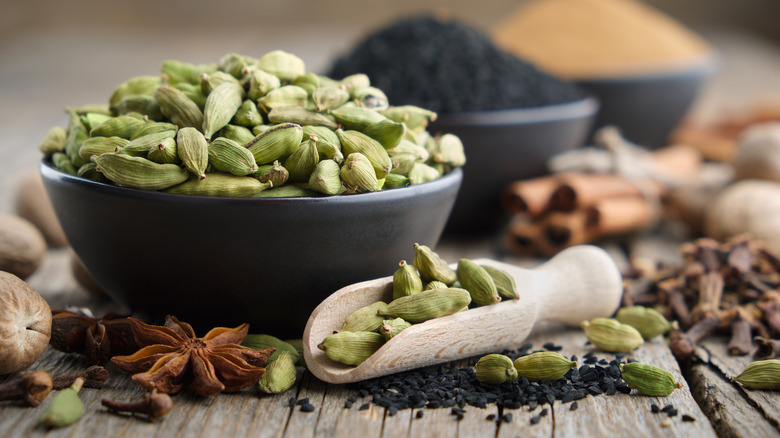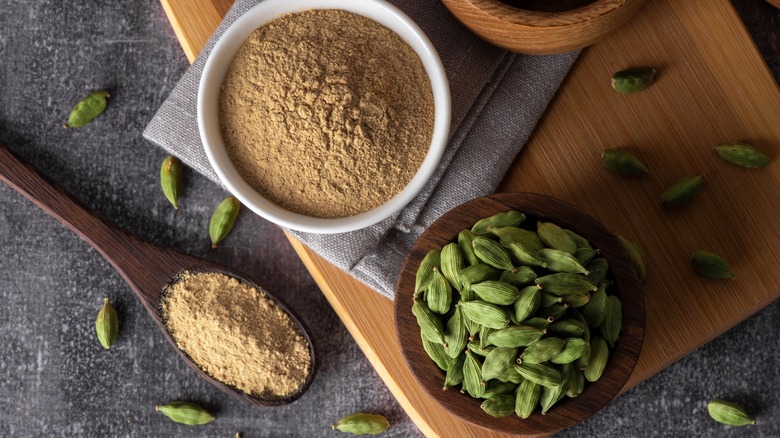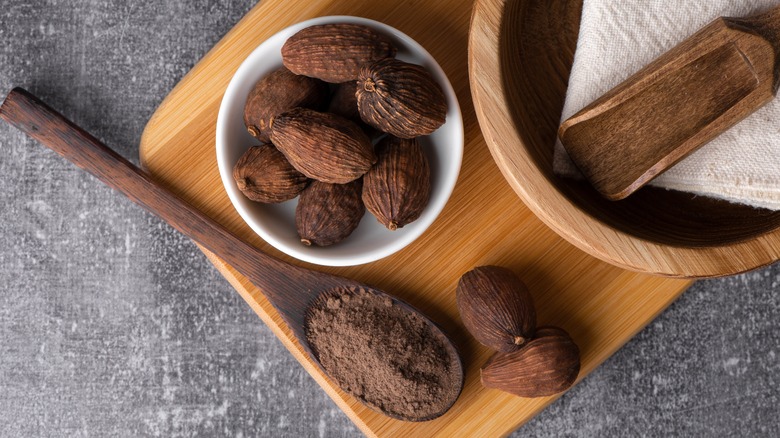How Are Green And Black Cardamom Different?
Do you love a little pepper on your mashed potatoes? How about nutmeg in your eggnog or cinnamon in your classic pumpkin pie recipe? The point we're trying to make is that without the power of spices in our favorite meals, they wouldn't be the same! Spices are essential to our culinary experience and cardamom is one of the most essential.
Mordor Intelligence claims that cardamom is spice royalty and demand for the precious commodity is coming from every continent. What is the reason people love it so much? Cardamom is versatile and is perfect for adding depth to both sweet and savory dishes. Cardamom powder is made from a seed pod, but the spice can be used whole or ground. It's also considered one of the world's expensive spices. With it being so widely enjoyed, it might be surprising to find how few people understand the contrast between the different types of cardamom.
How types of cardamom differ
The Greeks named cardamom a blend of words for "spice" and "cress" to describe both the black and green varieties, even though they look and taste different from one another (via Britannica). So, what's the deal? Is there such a big difference between these two spices from the ginger family?
Well, according to Masterclass, while both types of cardamom are delicious and widely used in Asian cuisine, especially in India, the spicy, peppery-sweet notes vary between the two. Masterclass says green cardamom (chhoti elaichi) uses the pod and seed and has a pungent aroma and flavor, which lends itself to dishes like Soan Papdi, Masala Chai, Chicken Tikka Masala, and Massaman Curry Paste. But, when we turn to take a look at black cardamom (motti elaichi) the flavor notes change. Sure, the black pods still have the same peppery notes, but there is a bold, smoky flavor.
Serious Eats says that black cardamom is traditionally dried over fire, and has a camphor and menthol note like that of mint! Black cardamom is considered a warm spice like black pepper and is therefore used to add a forceful, funky kick to whatever dish it's mixed into. This means that it would pair excellently with spicy or heavier recipes because of the dark taste it brings to food.
Where each is grown
Cardamom, like the coffee and black pepper plant, thrives in warm climates, making South Asia and Central America ideal growing regions for the spice. Slo Food Group says that green cardamom pods are specifically native to southeast Asia and India, preferring high altitudes and warm weather. So, while many countries like Indonesia, Vietnam, China, and India grow cardamom, another growing region has begun producing massive amounts of spice.
Olfactive Studio explains how the country of Guatemala recently conquered the cardamom market. For centuries, India held firmly to the title of primary cardamom producer, but the Olfactory Studio explains that after Oscar Majus Kloeffer brought the spice over to the New World in 1914, everything changed. Now, Guatemala is crowned as the largest exporter of cardamom worldwide, growing both green and black varieties of the plant. Black cardamom specifically is less popular than green and originated in Sikkim, India, and Nepal (via North Carolina Extension Gardener).
Can you swap one cardamom for the other?
You should definitely be cooking with cardamom, but how, and can you swap green for black? You can buy cardamom seeds whole or ground, but you'll need to be careful when adding them to your dish. According to Taste of Home, cardamom pairs well with meats, baked goods, and essentially most warm drinks and dishes; however, it can overpower your food quickly, so add it into your recipe slowly and taste test along the way!
As for whether you can swap out the types, Tarladalal advises using black cardamom on rice, soups, chowders, casseroles, and things like marinades to give them its notable smoky flavor. It is also an essential ingredient in garam masala, which is a spice blend used to make an Indian curry. You can obviously replace black with green cardamom if you want, but you should know that in doing so the taste of your dish will be altered.
Green cardamom is much more intense than black with its traditional flavors, but doesn't have that characteristic smokiness, so if you are relying on that note to make or break your dish, best not to substitute it. Sweetish Hill recommends that if you need a substitute for green cardamom pods, use cinnamon, nutmeg, and allspice together instead of black cardamom to better emulate the natural flavor of the spice.



